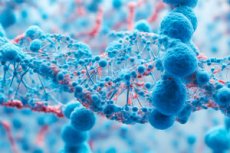New publications
RSPO2: A New 'Engine' for Metastatic Prostate Cancer
Last reviewed: 18.08.2025

All iLive content is medically reviewed or fact checked to ensure as much factual accuracy as possible.
We have strict sourcing guidelines and only link to reputable media sites, academic research institutions and, whenever possible, medically peer reviewed studies. Note that the numbers in parentheses ([1], [2], etc.) are clickable links to these studies.
If you feel that any of our content is inaccurate, out-of-date, or otherwise questionable, please select it and press Ctrl + Enter.

A new study has shown that changes in the RSPO2 gene occur in a significant proportion of patients with metastatic prostate cancer and are associated with a more aggressive course of the disease. RSPO2 enhances epithelial-mesenchymal transition (EMT) programs, is associated with “androgen-independent” subtypes, and can push the tumor to resist hormonal therapy. The study was published in the journal Oncotarget;.
Background
- Why Wnt signaling again. The Wnt/β-catenin pathway is one of the key drivers of tumor plasticity, migration, and drug resistance. R-spondin family proteins (RSPO1–4) enhance the Wnt signal via LGR4/5/6 receptors by suppressing E3 ligases RNF43/ZNRF3 and thereby “preserving” Wnt receptors on the membrane; RSPO has been described to have both LGR-dependent and alternative signal amplification mechanisms. This makes RSPO promising oncogenic modulators.
- In the prostate, “core Wnt” mutations are rare, suggesting that bypass pathways are at work. Direct CTNNB1 (β-catenin) mutations in prostate cancer have historically been found in only ~5% of tumors; APC changes are also not dominant. Hence the interest in Wnt “add-ons” — such as RSPO-LGR-RNF43/ZNRF3 — that can activate the pathway without classical mutations.
- Clinical context: avoiding androgen dependence. Current therapy is based on androgen receptor (AR) blockade, but some tumors under treatment pressure shift to AR-independent phenotypes (including double-negative prostate cancer, DNPC). DNPC is characterized by shifts toward Wnt/β-catenin, HGF/MET, and FGF/MAPK — this is associated with metastasis and resistance.
- Why RSPO2 is in the crosshairs: New analyses of large cohorts of metastatic prostate cancer have compared the RSPO family head-to-head. It turns out that RSPO2 alterations are more common than other RSPOs and some Wnt nodes, and are associated with a more aggressive course — making RSPO2 a candidate for driving progression. These findings are outlined in the original Oncotarget paper and recounted in News-Medical.
- Therapeutic implications and limitations of the field. The idea of targeting Wnt/RSPO looks attractive (e.g. PORCN inhibitors like WNT974/LGK974 or antibodies against Frizzled), but clinical trials have often been limited by toxicity (including bone events) and narrow therapeutic windows - this pushes us to search for more "spot" nodes, such as RSPO2.
- Fundamental basis for drug design. Recent structural work on LGR4–RSPO2–ZNRF3 shows how the complexes rearrange conformations and unleash Wnt signaling, providing molecular clues for the design of antibodies/inhibitors against the RSPO module.
What did they do?
The scientists analyzed large genomic cohorts of primary and metastatic prostate cancer (including SU2C-2019) and compared four members of the R-spondin family (RSPO1/2/3/4) with key components of the Wnt/β-catenin pathway (APC, CTNNB1). They then tested the effect of RSPO2 in laboratory models: expression of signaling pathways, proliferation, EMT marker genes, as well as structural differences of the RSPO2 protein from other R-spondins.
Key Results
- RSPO2 is the most frequently altered family member. In metastatic prostate cancer, RSPO2 amplification was found in approximately 22% of SU2C patients, which is higher than the frequency of CTNNB1 alterations and comparable/higher than APC. Overall, across 16 datasets, RSPO2 is the most frequently altered family member.
- Worse survival and "malignant" features. Carriers of RSPO2 amplification had more unfavorable parameters (disease-/progression-free survival), higher TMB and aneuploidy; RSPO2 amplifications were more common in metastases than in primary tumors.
- Triggering the “migration mode.” In cell models, overexpression of RSPO2 enhanced the EMT pathway and the transcription factors ZEB1/ZEB2/TWIST1; this effect was not observed with overexpression of CTNNB1 under the same conditions.
- Shift from AR dependence. According to transcriptomic data, RSPO2 was negatively correlated with androgen receptor (AR) activity and markers of AR subtypes and, conversely, positively correlated with signaling and factors characteristic of the “double negative” subtype (DNPC), which does not rely on AR and is often associated with treatment resistance.
Why is this important?
Metastatic prostate cancer therapy has been built around androgen receptor blockade for decades. But some tumors develop AR-independent behavior (including DNPC), where alternative pathways (FGF/MAPK, Wnt, etc.) take the leading role — these are the cases that respond worse to standard antiandrogens. The new work adds RSPO2 to the list of potential drivers of this shift and explains why the disease becomes more migratory and resistant to therapy in some patients.
A little context: what is RSPO
R-spondin proteins (RSPO1–4) are secreted modulators of the Wnt pathway: via LGR4/5/6 receptors and ZNRF3/RNF43 ligases, they enhance the availability of Wnt receptors on the membrane and thereby potentiate β-catenin signaling. RSPO2/RSPO3 are considered the most active and can work even outside the classical LGR-dependent mechanism. In oncology, RSPO rearrangements and overexpression have been described in several tumor types.
What can this give to patients?
- New target. RSPO2 is a secreted protein; the authors explicitly state that blocking antibodies or similar drugs are potentially useful for suppressing RSPO2-dependent tumors and may complement/replace Wnt-targeting approaches, which are still limited.
- Stratification biomarker. RSPO2 amplification/overload may help to identify patients at risk of AR-independent course, in whom alternative combinations and closer monitoring should be considered earlier. This requires clinical validation.
Restrictions
This is mostly association analysis in large cohorts plus in vitro experiments. The work still needs to be tested clinically: to what extent RSPO2 suppression actually improves survival and how to safely target this node in humans.
Sources: Oncotarget primary article (published July 25, 2025) and news article (August 11, 2025); review of the role of RSPO in oncology; materials on the subtype of AR-independent/DNPC prostate cancer. https://doi.org/10.18632/oncotarget.28758
